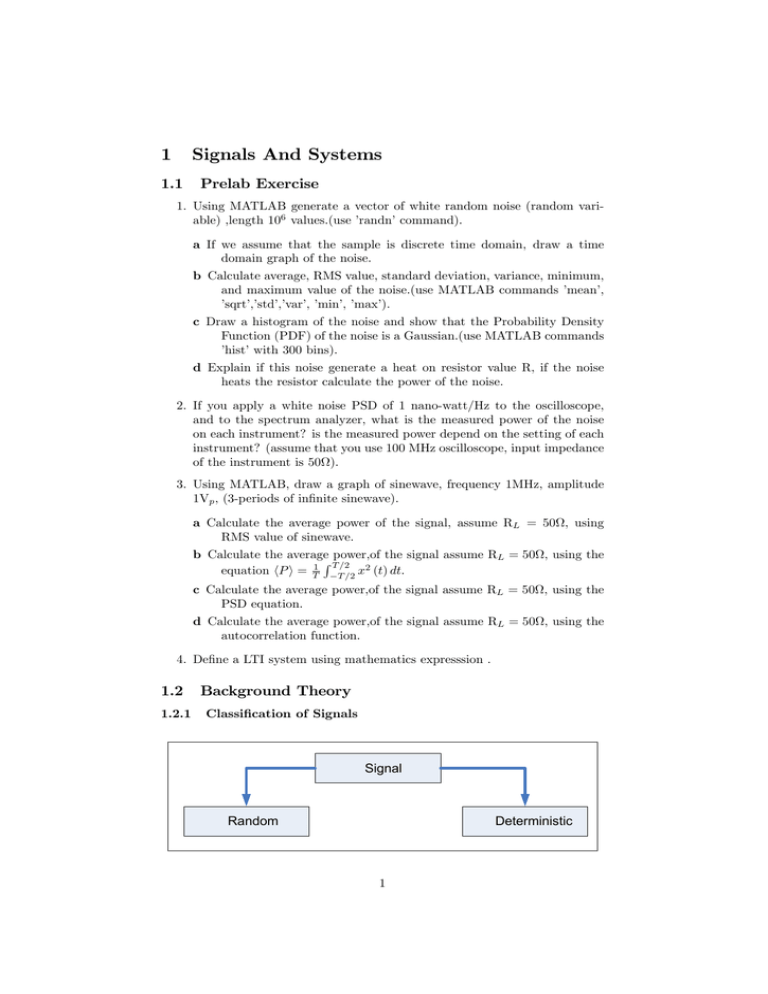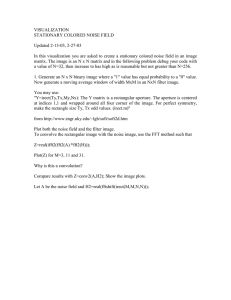1 Signals And Systems
advertisement

1 Signals And Systems 1.1 Prelab Exercise 1. Using MATLAB generate a vector of white random noise (random variable) ,length 106 values.(use ’randn’command). a If we assume that the sample is discrete time domain, draw a time domain graph of the noise. b Calculate average, RMS value, standard deviation, variance, minimum, and maximum value of the noise.(use MATLAB commands ’mean’, ’sqrt’,’std’,’var’, ’min’, ’max’). c Draw a histogram of the noise and show that the Probability Density Function (PDF) of the noise is a Gaussian.(use MATLAB commands ’hist’with 300 bins). d Explain if this noise generate a heat on resistor value R, if the noise heats the resistor calculate the power of the noise. 2. If you apply a white noise PSD of 1 nano-watt/Hz to the oscilloscope, and to the spectrum analyzer, what is the measured power of the noise on each instrument? is the measured power depend on the setting of each instrument? (assume that you use 100 MHz oscilloscope, input impedance of the instrument is 50 ). 3. Using MATLAB, draw a graph of sinewave, frequency 1MHz, amplitude 1Vp ; (3-periods of in…nite sinewave). a Calculate the average power of the signal, assume RL = 50 , using RMS value of sinewave. b Calculate the average power,of the signal assume RL = 50 , using the R T =2 equation hP i = T1 T =2 x2 (t) dt: c Calculate the average power,of the signal assume RL = 50 , using the PSD equation. d Calculate the average power,of the signal assume RL = 50 , using the autocorrelation function. 4. De…ne a LTI system using mathematics expresssion . 1.2 1.2.1 Background Theory Classi…cation of Signals Signal Random Deterministic 1 Fig.-1 Classi…cation of signals Deterministic Signal-For this Lab study of signals and systems, we will divide signals into two major groups: those that have a …xed behavior and those that change randomly. Most introductions to signals and systems deal strictly with deterministic signals. Each value of these signals are …xed and can be determined by a mathematical expression, rule, or table. Because of this, future values of any deterministic signal can be calculated from past values. For this reason, these signals are relatively easy to analyze as they do not change, and we can make accurate assumptions about their past and future behavior. Random Signals-Unlike deterministic signals, stochastic signals, or random signals, are not easy to analyze compare to deteministic signal. Random signals cannot be characterized by a simple, well-de…ned mathematical equation and their future values cannot be predicted. Rather, we must use probability and statistics to analyze their behavior. Also, because of their randomness, average values from a collection of signals are usually studied rather than analyzing one individual signal. 1.2.2 Signal Deterministic Signal-Periodic Determistic Periodic Nonperiodic Fig-2 Deterministic Signal classi…cation Periodic vs. Aperiodic Signal-Periodic signals repeat with some period T, while aperiodic, or nonperiodic, signals do not (Figure 3). We can de…ne a periodic function through the following mathematical expression, where t can be any number and T is a positive constant: f (t) = f (T + t) 1.2.3 Random Signal-Stationary Signal Stationary signal (Process)- Statistical properties of the signal or process unchanged over time. Nonstationary signal (Process)- Statistical properties of the signal (process) change over time. 1.3 Stationary ergodic process First order stationary process-A random process is classi…ed as …rst-order stationary if its …rst-order probability density function remains equal regardless of any shift in time to its time origin. If we let x (t1 ) represent a given value at time t1 , then we de…ne a …rst-order stationary as one that satis…es the following equation: f x(x (t1 )) = f x(x (t1 + )) 2 Random Stationary Nonstationary Figure 1: Fig-3 Classi…cation of random signal Stationary Process First order, Second Order, SSS,WSS Ergodic Figure 2: Fig-4-Random stationary process classi…cation The physical signi…cance of this equation is that our probability density function, f x(x (t1 )), is completely independent of t1 and thus any time shift, ;which mean that the …rst moment -mean is a constant over time. Second order stationary process: A random process is classi…ed as second-order stationary if its second-order probability density function ( variance) does not vary over any time shift applied to both values. For a second-order stationary process, we need to look at the autocorrelation function to see its most important property. Since we have already stated that a second-order stationary process depends only on the time di¤erence, then all of these types of processes have the following property: Rxx(t; t + ) = Rxx( ) Strict Sense Stationary process-Random processes are often referred to SSS when all moments of the distribution functions of the process are unchanged regardless of the time shift applied to them. Wide Sense Stationary process-In most of the cases it will become evident that the strict requirements of a SSS process is more than is often necessary in order to adequately approximate our calculations on random processes. We de…ne a …nal type of stationary, referred to as wide-sense stationary (WSS), to have slightly more relaxed requirements In order to be WSS a random process only needs to meet the following two requirements. E[x[n]] = constant Rxx(t; t + ) = Rxx( ) 3 Note that a SSS stationary process will always be WSS; however, the reverse will not always hold true. Stationary Ergodic Process An ergodic process is one which conforms to the ergodic theorem. The theorem allows the time average of a conforming process to equal the ensemble average. In practice this means that statistical sampling can be performed at one instant across a group of identical processes or sampled over time on a single process with no change in the measured result. Please see ergodic theory. 1.4 Average Normalized Power and PSD of Periodic Deterministic Signal The power spectral density (PSD) Sx (!) for a signal is a measure of its power distribution as a function of frequency. It is a useful concept which allows us to determine the bandwidth required of a transmission system. We will now present some basic results which will be employed later on. In general Fourier transform (FT) X(!) of a signal x(t) Z 1 X(!) = x(t)e j!t dt 1 For any periodic waveform with period T0 ; the spectrum of the waveform x(t) may be described by X(!) = n=1 X Cn (f nf0 ) n= 1 where f0 = 1 T0 and Cn is given by Cn = 1 T0 Z T0 =2 x(t)e j! 0 nt dt T0 =2 and where ! 0 = 2 f0 = 2 =T0 : We wish to …nd the normalized power (RL = 1 ) across distribution of x(t) as a function of frequency. For communications signals, the energy is e¤ectively in…nite (the signals are of unlimited duration), so we usually work with Power quantities. We …nd the average power by averaging the energy over time. Z 1 T =2 2 Average normalized power = hP i = x (t) dt T T =2 Using Parseval theory we may rewrite Z Z 1 T =2 2 1 hP i = x (t) dt = T T T =2 1 2 jX (!)j df = 1 Z 1 Sx (!) df 1 Where Sx (!) is the Power Spectral Density (PSD) of x(t);Periodic waveform may be described by Sx (!) = n=1 X n= 1 2 jCn j 4 (f nf0 ) X (ω ) S x (ω ) Y (ω ) H (ω ) H (ω ) S y (ω ) 2 Figure 3: Outtput of linear system in frequency domain And Sx (!) has units Watts/Hz. Another useful de…nition of PSD is given by the Fourier Transform of the autocorrelation function (ACF), Rxx( ) Z 1 Rxx( )e j! d Sx (!) = 1 where 1 Rxx( ) = hx(t)x(t + )i = T 1.4.1 Z T =2 x(t)x(t + )dt T =2 PSD of Random Signal The former de…nition of PSD result for deterministic signal holds for random signals, choosing for x(t) any randomly signal the PSD is given by the Fourier Transform of the autocorrelation function (ACF), Rxx( ) Z 1 Sx (!) = Rxx( )e j! d 1 Furthermore the total average normalized power for the waveform x(t) can be evaluated using any of the four techniques embedded in the following equation Z 1 2 hP i = x2 (t) = Vrms = Sx (!) df = Rxx(0) 1 1.5 Linear Systems and Power Spectra If we let x(t) a deterministic or random signal to pass through a linear system such as a …lter having a transfer function H (!) gives the output spectrum, Y (!) = H (!) X (!) hence the output PSD is 2 Sy (!) = jH (!)j Sx (!) where Sx (!) and Sy (!) are the PSD of the input and output signal respectively. 5 2 Experiment Procedure 2.1 Required Equipment 1. Function Generator Agilent-33220A. 2. Spectrum Analyzer Agilent ESA or equivalent 3. Oscilloscope .Tektronix TDS 4. Microphone with preampli…er. 5. T connectors 2 units. 6. Termination 50 Ohn 2 units. 2.1.1 Signal Deterministic Signal-Periodic Determistic Periodic Nonperiodic Fig-5 Deterministic Signal classi…cation 1. connect the system as indicated in Fig.-6 Tektronix TDS 2 0.0 33220 0,00 0 k-1 0 Hz F r e qAm p Of f se t Spectrum Analyzer CSA Fig-6 Deterministic signal measurement 2. Set the function generator to sinewave, frequency 100kHz amplitude 100mVpp 3. Now you watch a periodic deterministic signal in time domain. 6 4. Connect the signal to the spectrum analyzer, set the spectrum analyzer to center frequency 100kHz, span 1MHz, why the shape and bandwidth of the signal is not a Delta function?, why the sinewave have harmonics? measure the amplitude of the harmonics. 5. Assume that the sinewave signal has distorted by a system and become a square wave, connect a 100kHz squarewave amplitude 0 dBm, to the spectrum analyzer and calculate the total harmonics distortion-THD (use special function ’channel power’ or odd use 10 harmonics power for the calculation).Save the data on magnetic media. Pn n=3 P3 + P5 + P7 :::Pn Harmonics Power T HD = P1 Fundamental power 2.1.2 Signal Deterministic Signal-Non Periodic Since all your instrument design to analyze periodic signals, you can simulate a non periodic signal by setting the scope to capture a single shot signal of the function generator. 1. Connect the function generator to the oscilloscope indicated in Fig.-6 2. Set the function generator to sinewave frequency 1kHz amplitude 1Vpp output on. Burst ’1 Cyc’’trigger setup’’source’’manual’now the function generator generate one pulse, while you press on trigger button. 3. Set the timebase of the oscilloscope to 1ms, and amplitude to 500mv/div, and press on ’single sequence’button, now the scope is ready capture any single event. Press on trigger button and capture the one shot signal. 4. Now you watch a non-periodic, single shot deterministic signal in time domain.Save the data on magnetic media 2.1.3 Random Signal-Stationary Signal 1. Connect the function generator to the oscilloscope as indicated in Fig.-6. 2. Set the function generator to Noise amplitude 1Vpp. 3. Measure with oscilloscope the average of the signal (use DC coupling why)?, what is the expected value of the noise as a signal. Save 3 traces of the noise on magnetic media. Use MATLAB to …nd the averages and variance of the three traces of noise. According to your analyze is the noise of the function generator is stationary signal? explain. 4. Measure the RMS voltage of the noise signal, and calculate the normalized power of the noise signal in time domain. 5. Connect the noise signal to spectrum analyzer, set the spectrum analyzer to start frequency 50kHz stop frequency 5MHz, trace to maximum hold, measure the PSD (Power Spectral Density) across the frequency band, what is the shape of the noise in frequency domain, is it baseband or bandpass noise explain? Measure the total noise power (5MHz), and the PSD of the noise, (use channel power function) 7 Tektronix TDS Microphone Preamplifier Figure 4: Fig.-7 Voice signal Non stationary random signal 2.1.4 Random Signal-Non-stationary Signal 1. Connect the microphone with preampli…er to the oscilloscope as indicated in Fig.-*** 2. Whistle or speak into the microphone, Save 3 traces of the voice signal on magnetic media. Use excel spread sheet or MATLAB to …nd the averages and the variance of the three traces of voice . According to your analyze determine wether is the voice signal; is a stationary signal ? 2.1.5 Deterministic Signal Buried in Random Noise Sometime you are required to extract a signal which burried in noise, in this chapter we will examine two ways to perform such a task. 1. Connect the function generator to the oscilloscope as indicated in Fig.-8. 8 Tektronix TDS 2 0.0 33220 0,00 0 k-1 0 Hz F r e qAm p Of f se t 2 0.0 33220 0,00 0 k-1 0 Hz F r e qAm p Of f se t Figure 5: Fig-8 Setup for signal burried in noise 4 3 2 1 0 -1 -2 -3 0 50 100 150 200 250 300 350 400 450 500 Fig-9-Signal burried in noise 2. Set the function generator to noise amplitude 1Vpp. 3. Set the Signal generator or function generator to sinewave frequency 1MHz amplitude 100mv. 4. Watch the signal on the oscilloscope, using your test equipment, …nd a way to recover the signal buried in noise.Save the data on magnetic media 9 Additive White Gaussian Noise and Signal Extraction. Sometime you have the ability to characterize the noise, you can use use the additive characteristic of the noise, in order to extract the signal which burried in noise. 2.1.6 Impulse Response of Linear Time Invariant (LTI) System In this section RC low pass …lter will be our LTI system, we will simulate and measure the impulse response and the output of the …lter, in time and frequency domain. System Linear System Time Invariant Non-Linear System Time Variant Time Invariant Time Variant Fig-10 Classi…cation of system Simulation 1. Find the transfer function of the RC …lter in the frequency domain (as a function of s),assume = 0:5m sec.. 2. Use MATLAB to …nd the impulse response of the LTI system (use the symbolic command syms a s t w x; ilaplace(1/(1+ s)) 3. Plot the impulse response of the system as a function of time, can you explain the shape of the response? 4. Using the impulse response of the system, …nd vo (t) the time response of the system to the sinewave input vin (t) = sin(2 3000t) :(use the MATLAB command ’conv’) Procedure 1. Connect the system as indicated in Fig-11. 2. Set the function generator to nearly impulse function, pulse frequency 100Hz amplitude 5Vpp, duty cycle 0.1%, o¤set 2.5VDC. Watch the signal on oscilloscope to verify your setting. 10 Tektronix TDS 20.000,000 kHz 33220-1 Freq Amp Offset 100k ohm 5nF Fig-11 Impulse response of LTI system 3. Compare the shape of the impulse response to the simulation. 4. Set the function generator to sinewave frequency 3kHz amplitude 1Vpp.compare the signal to the simulation. 2.2 Average Power and PSD 1. Connect the function generator directly to the oscilloscope.(see Fig.-6) 2. Set the function generator to sinewave, frequency 1kHz amplitude 1Vpp 3. Measure the rms value of the signal and calculate the average power of the signal, assuming RL = 50 . 4. Store the data on magnetic media, and use Excel worksheet or MATLAB to calculate the average power,assuming RL = 50 . using the equation hP i = x2 (t) =50. 5. Connect the signal to the spectrum analyzer, and measure the average R1 power assuming RL = 50 using the equation hP i = 1 Sx (!) df: 6. Calculate the autocorrelation function of sinewave at RL = 50 ; compare your answer to the previous results. 2.3 = 0 assuming Final Report 1. Attach all the graph and answer to all the text question. 2. Use MATLAB to show that white noise is WSS process (show the graph of relevant statistic of 3 vectors, length 105 elements each, use ’randn’command).. 3. Use MATLAB to show that white noise is ergodic stationary. a Generate matrix 300 rows and 300 columns. each row represent a vector of 300 white noise elements. b …nd the mean of each row, and draw a graph of the means, show that the mean is relatively unchange over time. 11 c …nd the variance of each row, and draw a graph of the variances, show that the variance is relatively unchange over time. d …nd the mean of each column, and draw a graph of the means, show that the mean of the columns is similar to the rows.. e …nd the variance of each column, and draw a graph of the variances, show that the variance of the columns is similar to the rows.. 12




